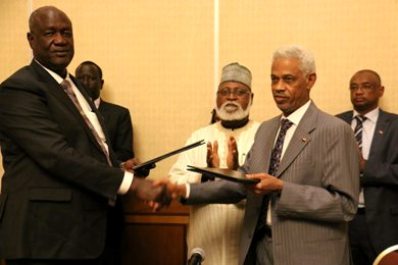Sudan and South Sudan agree to activate border monitoring operations
October 14, 2015 (ADDIS ABABA) – Sudan and South Sudan Wednesday agreed to activate a buffer zone between the two countries and to deploy joint units to monitor the border, three years after the signing of security arrangements agreement in September 2012.

“The Parties agreed to activate all the mechanisms relating to the JPSM as provided for in the relevant agreements, in particular the JBVMM in coordination with the UNISFA (of Abyei area),” said a statement released on Wednesday .
On 27 September 2012, the two countries signed a security agreement with the purpose of stopping the flow of guns and supplies to the rebel groups across the border. Khartoum and Juba accused each other of backing armed movements.
South Sudan was reticent to the implementation of the agreement, fearing that delimitation of the centreline, which passes through contested areas, may be seen as final location of the boundary. On 22 November 2013 Juba suspended its participation in the JMVMM ending the monitoring operations.
However, Wednesday’s statement says that the two sides accepted the map presented by the AUHIP to the parties in November 2011. It further stressed that the centreline and buffer zone, which run 10 km along either side, “represent only the location of the separation line between the armed forces of the two States”.
The agreement also provides that the centreline will not affect the current administrative arrangements in any area along the demilitarized zone.
In the recent peace agreement signed in August between South Sudanese president Salva Kiir and the armed opposition leader, Riek Machar, the parties agreed that South Sudan’s government should “disarm, demobilize and repatriate” the Sudanese rebels from the territory of the Republic of South Sudan within 45 days from the signing of the peace deal.
The peace agreement calls for withdrawal of all foreign forces, the Ugandan People’s Defence Forces (UPDF) on Monday also announced that it started to withdraw its troops from South Sudan’s soil.
The agreement was witnessed by Abdulsalam Abubakar of the African Union High Level Implementation Panel (AUHIP) which facilitated the meeting. It was co-signed by Sudan’s defence minister Mohamed Ahmed Ibn Ouf and his South Sudanese counterpart Kuol Manyang Juuk.
It was also decided that the JPSM will hold its next ordinary meeting in Khartoum on 16 November where they will discuss a report by UNFISA force commander.
(ST)
